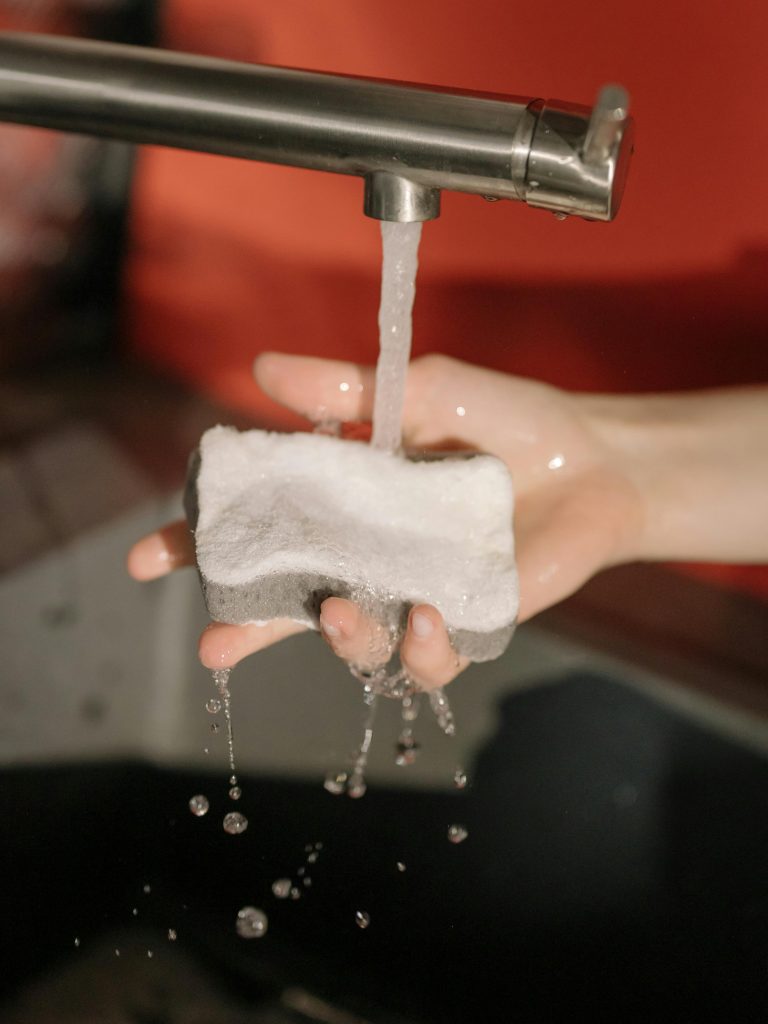All fields are required
Posted in E. coli,Our Blog,Salmonella,Staphyloccocous on August 27, 2024

It is so easy to get wrapped up in household chores and just toss a used sponge into the bottom of the sink and forget it until the next use. I have been guilty of it and I am sure so many others are as well. Did you know you should clean a sponge? How dirty is your sponge? Without proper cleaning Salmonella, Staphylococcus aureus, and E. coli can live up to 16 days in it.
The “sponge problem” is the textbook example of, first, the need for vigilance and focus in the fight. Working against us is our innate laziness. On the long list of things that are of paramount importance, day in and day out, cleaning the sink-side sponge — as we’re tuckered out from the daily grind and have just gotten the kids fed — is not high on the list.
The job of a sponge is to be your pots’ and pans’ garbage truck for bio-waste. From the point of view of the bacteria, who do not care about what use you have for the thing, the sponge is that special place in your kitchen that never dries out, is repeatedly made warm, and most dangerously, regularly has its food muck supply replenished every time you clean a pan or a dish or wipe a prep surface with it.
But the first main step to take in the fight is to change the way we think about sponges. Kitchen-borne pathogens like being alive, which means that they will take any opportunity, to ensure their own survival, as all bacteria do. That, in turn, means that your own household Campylobacter and Salmonella attack squads will keep on battling for their survival when the kitchen has (according to you) been cleaned and you’ve retired to your recliner.
Dry Them Out-
First, a general tactical rule of the road: Don’t stack your sponges atop each other sink-side, and certainly don’t marinate them in a soap dish. Between uses, they need a shot at drying out. Got a dishrack? Store your sponges vertically in there as you finish the washing up.
Use Baking Soda-
Take a little bowl and make a paste from a couple of tablespoons of baking soda and a bit of water and swish your sponge around in it for a few minutes. Squeeze and let dry. Baking soda is a base or alkaline compound, which means it cleans by raising the pH. Note: A baking soda bath won’t completely disinfect your sponge, but it’s a good start in making them hostile to bacteria. Its crystals form an abrasive, which is why it’s also good for cleaning pans or surfaces without scoring them.
Use Vinegar-
Vinegar, which is acidic, will dramatically lower the pH in your sponge — and it’s more hostile to bacteria than baking soda. A full-strength white vinegar bath for five minutes in a dish or a small bowl is recommended. Estimates vary, but vinegar baths have been judged to kill some 99.6% of bacteria. As with baking soda, vinegar’s delightful edibility is key.
Think Bleach– But Rinse Well
A bleach bath, which researchers agree can kill just about anything, including you, is what we might call the nuclear option. As such, it’s a double-edged sword because it’ll take more than a few rinses to flush the sponge of bleach. Recommended is three-quarters of a cup of bleach in a gallon of water (or three-sixteenths of a cup in a quart), which is a fairly low intensity, but it does have a kill rate of 99.9%. Bear in mind that you’re using these sponges to clean the pans and the implements with which you cook. On balance, the effective difference between a vinegar bath and a bleach bath is three-tenths of one percent. Go for the vinegar.
Use the Microwave-
The U.S. Department of Agriculture research shows that radiation does kill an extremely high percentage of bacteria(99.9% to be precise). If you have the machine, by all means, don’t let us stop you from tossing your sponges in. Remember: No sponges with scouring pads containing metals attached!
Boiling Water-
By itself, boiling your sponge for a few minutes reduces its bacterial load. This doesn’t eliminate the “dead” bacteria though which becomes food for living bacteria.
Toss it in the Dishwasher-
This is like boiling, but letting the machine do it for much, much longer. Some folks do love their dishwasher. And, used with the drying cycle at its hottest, it has a similarly high bacterial kill rate to the microwave, beyond vinegar baths, at 99.9%. But here again, your simple hand work on a sponge can come very close to the dishwasher’s accomplishment, while saving many multiples of time, energy, and water. Finally, there’s this simple fact: Your hand can squeeze the sponge as you rinse it to flush out the dead bacteria.
For more food safety and kitchen tips please follow Make Food Safe as we update the blog daily with great tidbits of information for everyone.